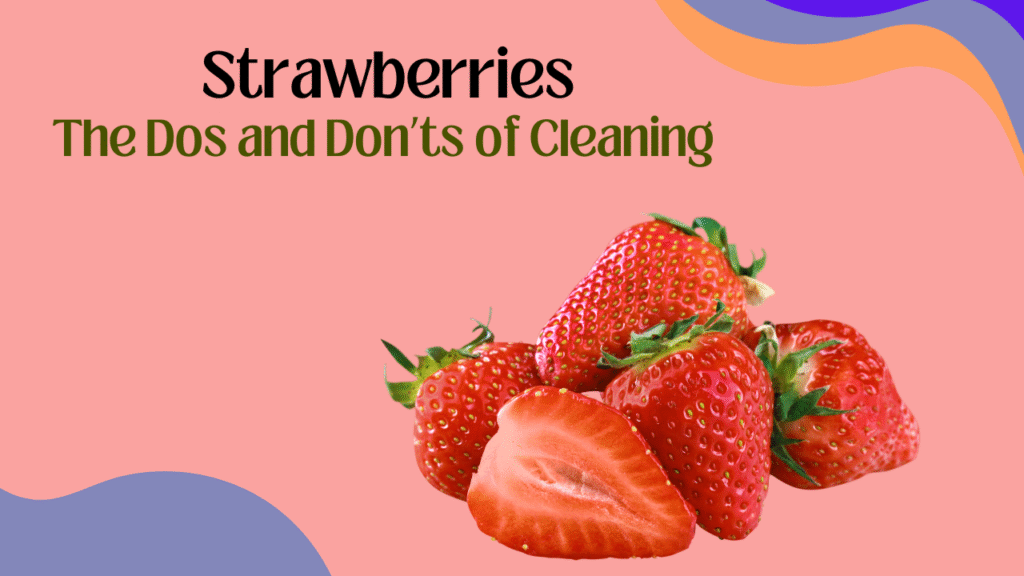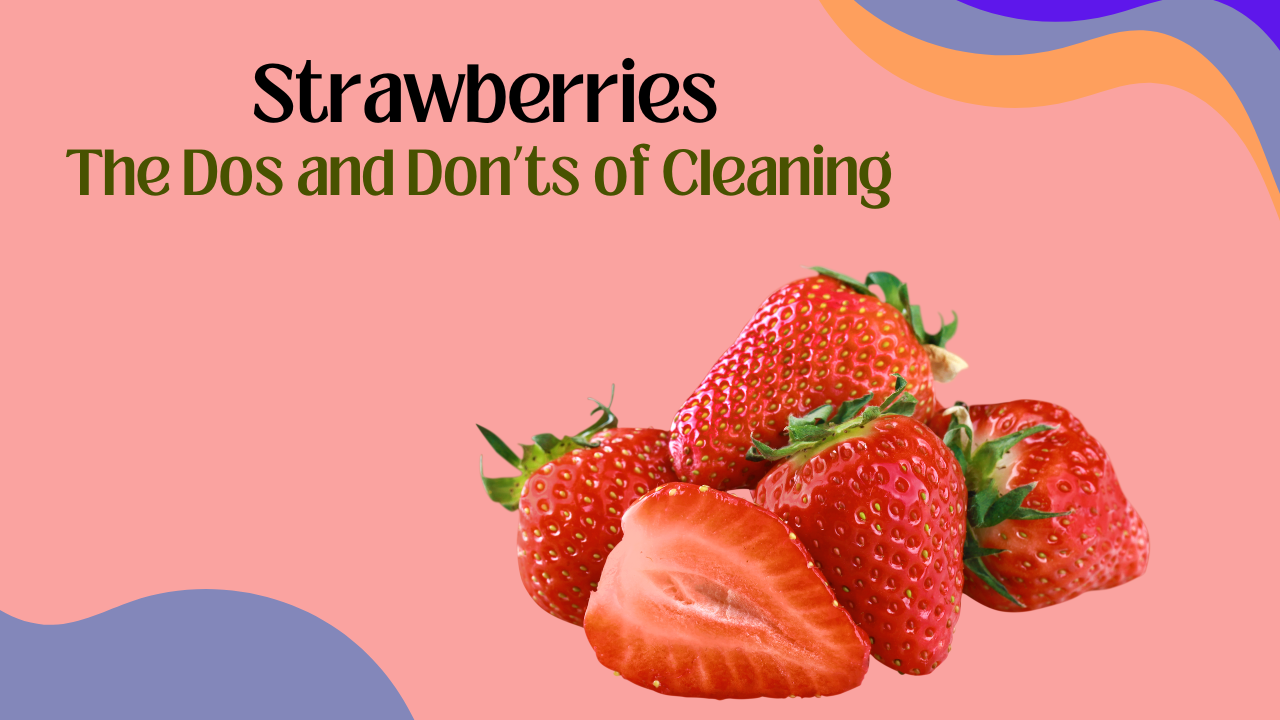Strawberries: The Dos and Don’ts of Cleaning – A Complete Guide

Strawberries are a favorite fruit – they’re tasty, healthy, and great for snacking or baking. But because they’re soft and have tiny holes in their skin, they can easily pick up dirt, germs, and pesticides. That’s why it’s important to clean them properly to keep them safe to eat and help them stay fresh longer.
In this simple guide, we’ll show you the best ways to clean strawberries, what to avoid, and how to store them the right way.
Why Cleaning Strawberries Matters
Strawberries often have pesticides on them, and their soft skin can hold germs, mold, and tiny bugs. Washing them well helps remove these things, keeps you safe from getting sick, and makes your strawberries last longer in the fridge.
The Dos of Cleaning Strawberries
1. Do Inspect and Sort Before Cleaning
Before you start, inspect your strawberries. Remove any that are bruised, moldy, or overripe. Damaged berries can spoil the whole batch and spread mold quickly.
2. Do Wash Your Hands First
Always wash your hands with soap and water for at least 20 seconds before handling strawberries. Clean hands prevent cross-contamination and keep your fruit safer.
3. Do Wait to Wash Until Right Before Eating
Moisture is the enemy of fresh strawberries. Only wash strawberries right before you plan to eat or use them. Washing in advance can cause them to spoil or grow mold faster.
4. Do Use Gentle Cleaning Methods
Strawberries are delicate and bruise easily. Whether rinsing or soaking, handle them gently to avoid damaging the fruit.
5. Do Choose an Effective Cleaning Method
There are several proven ways to clean strawberries:
- Cold Water Rinse: Place strawberries in a colander and rinse under cold running water, gently rubbing each berry with your fingers to remove dirt.
- Vinegar Soak: Mix 1 part white vinegar to 3 parts water. Soak strawberries for 5–10 minutes, then rinse thoroughly under cold water to remove any vinegar taste. This method helps kill bacteria and mold spores, extending shelf life.
- Baking Soda Soak: Dissolve 1 teaspoon of baking soda in 2–4 cups of water. Soak for 5–15 minutes, then rinse well. This is effective for removing pesticide residues.
- Salt Water Soak: Mix 1 tablespoon salt with 2 cups water. Soak for 5–10 minutes, then rinse. This draws out tiny insects and surface debris.
- Hot Water Bath: Soak berries in water heated to 125–130°F (52–54°C) for 30 seconds, then dry thoroughly. This can kill heat-sensitive bacteria and mold spores without damaging the fruit.
6. Do Dry Thoroughly After Washing
After cleaning, dry strawberries completely with a clean paper towel, soft cloth, or by air-drying on a towel. Moisture left on the berries can lead to mold and spoilage.
7. Do Store Properly After Cleaning
If you must store washed berries, line a container with paper towels, add the dried strawberries, and leave the lid slightly ajar for airflow. Store in the refrigerator and consume within 2–3 days for best quality.
Also read:
How to Make Hot Honey: A Simple Guide
Lavender Tea – 10 Amazing Health Benefits You Need to Know
The Don’ts of Cleaning Strawberries
1. Don’t Remove the Hull Before Washing
Keep the green tops (hulls) on while washing. Removing them allows water to enter the berry, which can dilute flavor and make them mushy.
2. Don’t Soak for Too Long
Over-soaking, especially in vinegar, salt, or baking soda solutions, can affect the berries’ flavor and texture. Stick to the recommended soak times (usually 5–10 minutes).
3. Don’t Wash Too Early
Washing strawberries before storing them can cause them to spoil faster. Wait until just before use to clean them.
4. Don’t Use Soap or Detergent
Never use soap or dish detergent to clean strawberries. Their porous skin can absorb these substances, making them unsafe to eat and affecting their flavor.
5. Don’t Skip the Drying Step
Storing wet strawberries encourages mold growth. Always dry them thoroughly before storing.
6. Don’t Use Dirty Towels or Containers
Always use clean towels and containers for drying and storing strawberries. Dirty equipment can reintroduce bacteria or mold.
7. Don’t Overcrowd When Storing
Avoid piling strawberries on top of one another. Overcrowding can cause bruising and restrict airflow, leading to faster spoilage.
Step-by-Step: How to Clean Strawberries the Right Way
1. Inspect and Sort
Remove any damaged, moldy, or overripe berries.
2. Choose Your Cleaning Method
For everyday cleaning, a cold water rinse is sufficient.
For deeper cleaning, use a vinegar, baking soda, or salt soak.
3. Soak or Rinse
If soaking, gently swish the berries in your chosen solution for 5–10 minutes.
If rinsing, hold each berry under cold running water and gently rub.
4. Rinse Thoroughly
If using vinegar, baking soda, or salt, rinse the berries under cold water to remove any residue.
5. Dry Completely
Lay berries out on a clean towel or pat gently with paper towels until fully dry.
6. Store Properly
If not eating immediately, store in a paper towel-lined container with the lid slightly open in the fridge.
For longer storage, freeze cleaned and hulled strawberries in a single layer before transferring to a freezer bag.
Common Mistakes to Avoid
- Soaking too long: Leads to mushy berries and flavor loss.
- Washing before storage: Causes rapid spoilage.
- Not rinsing off cleaning agents: Leaves unpleasant taste.
- Removing hulls before washing: Allows water inside, making berries mushy.
- Skipping the drying step: Promotes mold growth.
- Using soap: Unsafe and affects flavor.
Special Tips for Organic and Conventional Strawberries
Both organic and conventional strawberries need thorough cleaning. Organic berries can still harbor dirt, bacteria, and natural pesticide residues, so use the same cleaning techniques for both.
Final Thoughts
Properly cleaning strawberries isn’t just about food safety—it’s about preserving their flavor, texture, and shelf life. By following these dos and don’ts, you’ll enjoy cleaner, fresher, and more delicious strawberries every time. Remember:
- Clean your hands and tools first
- Wash only before eating
- Use gentle, effective cleaning methods
- Dry thoroughly and store properly
With these tips, every bite of strawberry can be as safe and sweet as nature intended.
